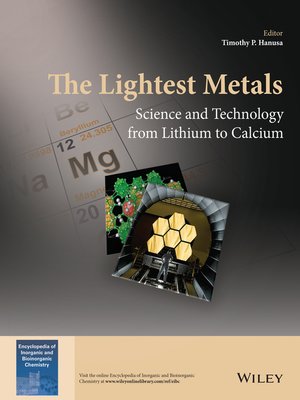The Lightest Metals
ebook ∣ Science and Technology from Lithium to Calcium · EIC
By Timothy P. Hanusa

Sign up to save your library
With an OverDrive account, you can save your favorite libraries for at-a-glance information about availability. Find out more about OverDrive accounts.
Find this title in Libby, the library reading app by OverDrive.



Search for a digital library with this title
Title found at these libraries:
| Library Name | Distance |
|---|---|
| Loading... |
The first seven metals in the periodic table are lithium, beryllium, sodium, magnesium, aluminium, potassium and calcium, known collectively as the "lightest metals". The growing uses of these seven elements are enmeshing them ever more firmly into critical areas of 21st century technology, including energy storage, catalysis, and various applications of nanoscience.
This volume provides comprehensive coverage of the fundamentals and recent advances in the science and technology of the lightest metals. Opening chapters of the book describe major physical and chemical properties of the metals, their occurrence and issues of long-term availability. The book goes on to disucss a broad range of chemical features, including low oxidation state chemistry, organometallics, metal-centered NMR spectroscopy, and cation-π interactions. Current and emerging applications of the metals are presented, including lithium-ion battery technology, hydrogen storage chemistry, superconductor materials, transparent ceramics, nano-enhanced catalysis, and research into photosynthesis and photoelectrochemical cells.
The content from this book will be added online to the Encyclopedia of Inorganic and Bioinorganic Chemistry: http://www.wileyonlinelibrary.com/ref/eibc
This volume provides comprehensive coverage of the fundamentals and recent advances in the science and technology of the lightest metals. Opening chapters of the book describe major physical and chemical properties of the metals, their occurrence and issues of long-term availability. The book goes on to disucss a broad range of chemical features, including low oxidation state chemistry, organometallics, metal-centered NMR spectroscopy, and cation-π interactions. Current and emerging applications of the metals are presented, including lithium-ion battery technology, hydrogen storage chemistry, superconductor materials, transparent ceramics, nano-enhanced catalysis, and research into photosynthesis and photoelectrochemical cells.
The content from this book will be added online to the Encyclopedia of Inorganic and Bioinorganic Chemistry: http://www.wileyonlinelibrary.com/ref/eibc







